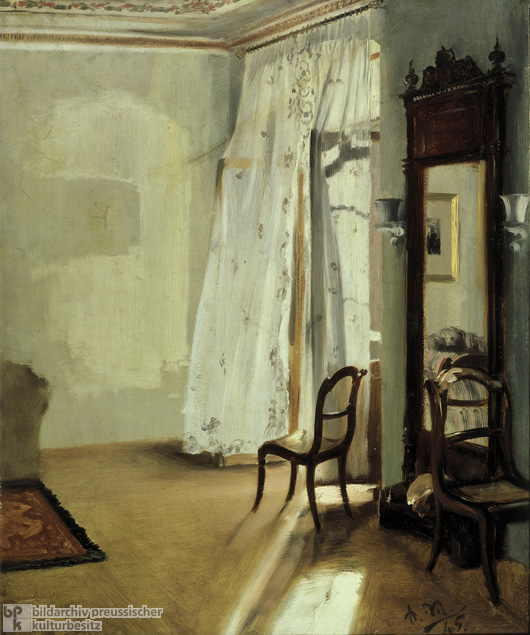|
Adolph von Menzel, The Balcony Room (1845)
Any viewer of this astonishingly lovely little picture by Adolph Menzel (1815-1905) must be struck by a number of qualities perhaps best described as uncannily modern. It is spare, light, seemingly uncomposed, unevenly finished, spatially ambiguous, and entirely devoid of any sort of moral, religious, historical, allegorical, or narrative content. It differs dramatically from most of the visual models available in the mid-1840s, such as the storybook illustrations of the last generation of Bavarian Romantics and the neoclassical perfection of paintings in the official academic style. Even the most intimate and personal Biedermeier interiors – to which The Balcony Room is certainly indebted – look like stage sets for bourgeois comedies when placed alongside this picture, which introduces the artist’s ordinary, everyday surroundings as a powerful and legitimate subject of painting. Menzel’s early masterpiece was part of a new tradition of “private” art – that is, art that was made primarily for the sheer pleasure of the artist rather than the benefit of a large audience. Because such works did not usually face public scrutiny, they were freed from academic convention and thus often retained the freshness and immediacy of watercolors or preparatory oil sketches. “Private” paintings were frequently collected by the artist’s family, friends, and students, as well as other artists, and were often exhibited only after the artist’s death. (The Balcony Room, for example, was not shown publicly until Hugo von Tschudi organized a commemorative exhibition at the Nationalgalerie in Berlin after Menzel’s death in 1905.) Following the lead of the early 19th-century Romantics, who placed high value on unmediated sensations and spontaneous outpourings, certain progressive painters – most notably the landscapists Franz Ludwig Catel, Carl Blechen, and Carl Rottmann – began to embrace the “private” work as a means of pushing the boundaries of what was acceptable in painting. Increasingly, sketch-like works were signed and dated on the front (as is The Balcony Room), just like “finished” paintings. The rise of “private” works was as much societal as aesthetic, however: the decline of traditional court and church patronage, coupled with the rise of a prosperous middle class created a new market for smaller, unostentatious works meant for the decoration of private houses. Additionally, the new modern taste for depictions of contemporary life made officially sanctioned academic art seem static and artificial in comparison. As a result, the sketches and smaller impressionistic works of painters such as Menzel and Blechen (whom Menzel greatly admired) gained in popularity and were celebrated for their prescient modernist mastery of color and light, and their ability to capture an ephemeral moment.

|


